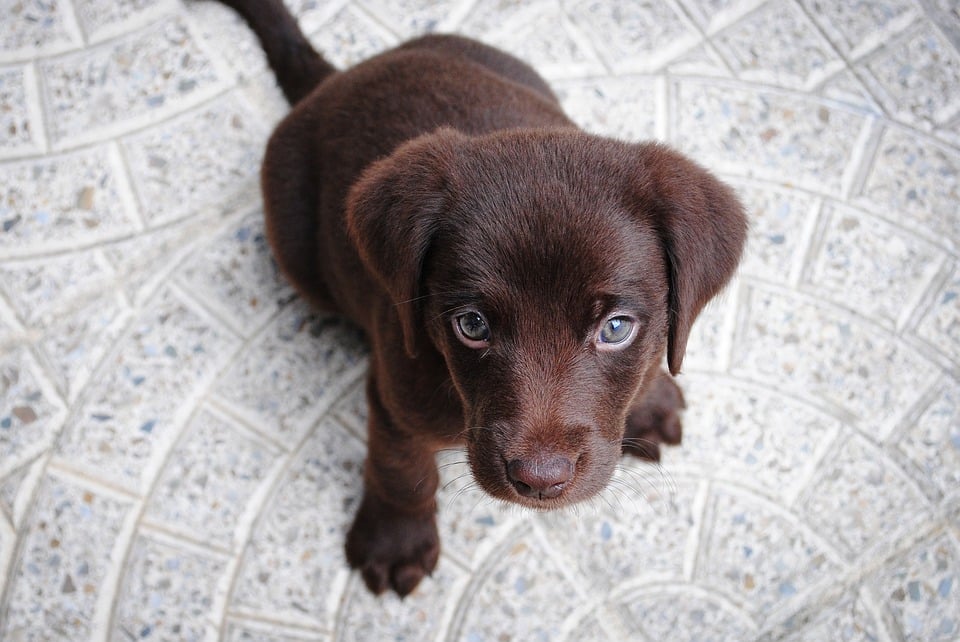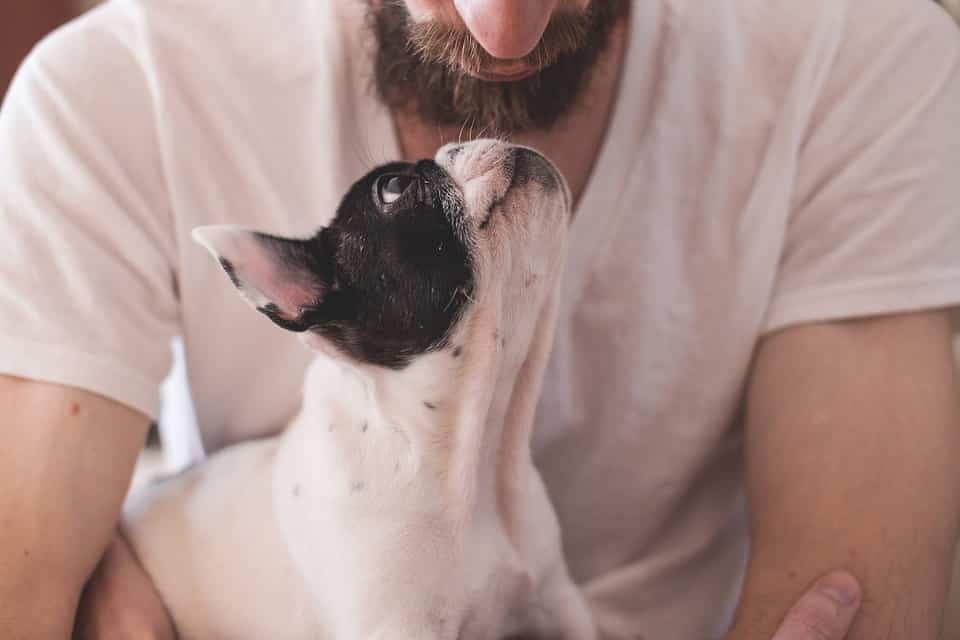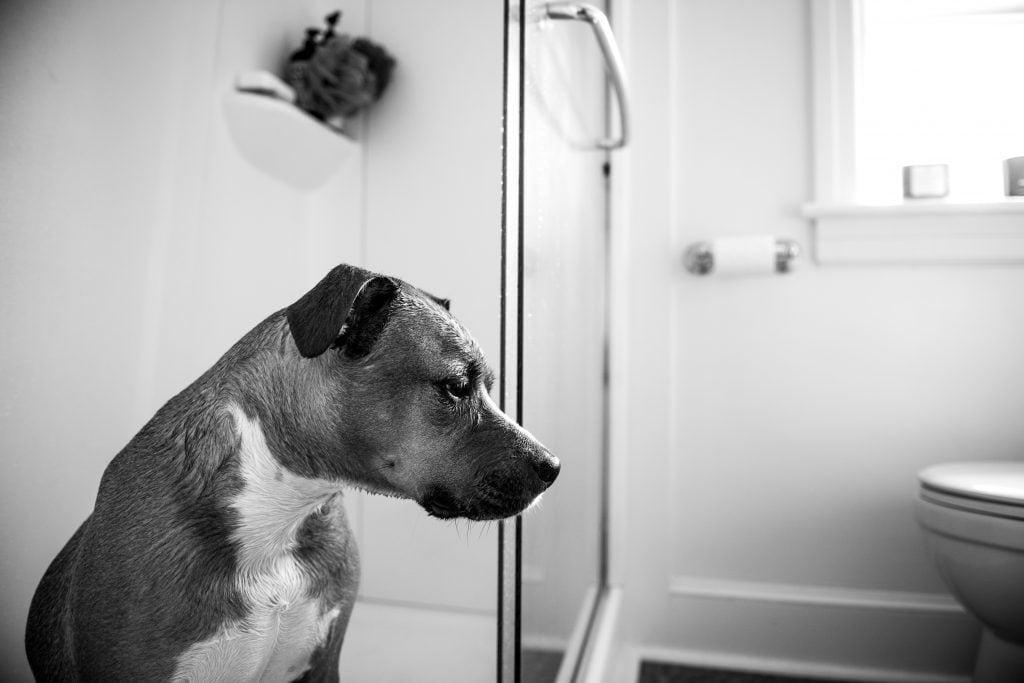Do you often hear the tap-tap of doggy toenails on the tile when you head to the bathroom? Do they wait on the bathmat while you shower, or watch you while you brush your teeth? Some dogs are just unwilling to leave your side even while you, ahem, do your business.
For dog people, it may seem obvious: dogs love to be around us, so of course they want to join us in the bathroom, too! But it’s not as simple as that. As it turns out, there are some scientific explanations for why dogs follow you into the bathroom. Let’s take a look at some of the reasons your dog keeps following you into the bathroom—and everywhere else.
Socialisation

via Pixabay
If your dog was a tiny puppy when they joined your family, they may be particularly accustomed to being with you all the time. In an interview with PetMD, Certified Applied Animal Behaviourist Mary Burch explains that “puppies can imprint on people” in the first few months of their life. Imprinting is when a young animal comes to recognize another animal, person, or thing as a parent figure or object of habitual trust.
If your puppy imprinted on you, it’s no wonder they want to stay close at all times!
But dogs don’t have to be imprinted to be loyal. You can adopt a senior dog, an adolescent, or any age between, and as long as your dog comes to see you as the most trusted figure in their life, they may well follow you around. Dogs are socialized to stick close to the ones they love—even when their loved one is on the toilet.
Companionship

via Pixabay
Dogs are pack animals by nature, and historically traveled and lived together in close-knit groups. Village dogs around the world still do this, in fact. Domestic pet dogs no longer run in packs, but they’re still hardwired to find comfort among others. Plus, during centuries of domestication, dogs have evolved to become more and more bonded with humans. You are your dog’s closet companion, and being close to you means food, safety, and happiness.
On the flip side, being separated from you may mean anxiety or distress. You’re their pack now—and for some dogs, that means not letting anything, not even the pesky bathroom door, come between you.
Breed Traits
https://www.instagram.com/p/Bs-Ynl9lFUB/?utm_source=ig_web_copy_link
Have you ever heard border collies referred to as “Velcro dogs?” Some breeds are more inclined to follow humans than others due to inborn traits. Herding breeds like border collies, shepherds, and cattle dogs may want to keep the whole family rounded up. Loyal working dogs like doberman pinschers and boxers may want to stick close to keep an eye out for danger. And sporting breeds like Labrador retrievers and pointers might just enjoy sticking close to their favorite person.
There’s no official “Bathroom Group” of dogs, but some breeds are more inclined than others to join people in the porcelain palace.
Curiosity
https://www.instagram.com/p/BpC297JnPMd/?utm_source=ig_web_copy_link
Dogs are naturally curious creatures. When you get up to move from one place to another, your dog wonders what’s going on. Are you off to retrieve a treat for them? Or perhaps you’re headed to a fun activity they’d hate to miss out on.
When your dog follows you into the bathroom, he may be sating his natural curiosity. He wants to know what the heck you’re doing in there, and why that funny chair makes such a loud noise when you’re done!
Reinforcement
https://www.instagram.com/p/BtZdod4gsZw/?utm_source=ig_web_copy_link
What do you do when your dog follows you into the bathroom? Do you pet them and praise them, or redirect them out the door into another room? Either way, you’re giving them attention, and attention reinforces the behavior.
If you don’t mind having your dog in the room while you take care of business, it’s no big deal. On the other hand, if you’d prefer some privacy, you can train your dog to do something else.
No need to scold; you can simply reward a different behavior. For instance, use bathroom time as a training opportunity and have your dog practice their down-stay outside the door. When you come out of the bathroom, praise them and give them a treat for being so good. Over time, as you reinforce different behavior, you can break their habit to watch you on the throne.
Anxiety

via Pexels
It’s perfectly healthy for your dog to want to be around you most of the time. After all, you’re bonded to each other, and that’s one of the best parts of having a dog! But if your dog cries nonstop when you close a door between you, or engages in destructive behavior when you’re apart, they may be showing signs of separation anxiety. In that case, simply letting them into the bathroom with you may be a quick fix, but it won’t help either one of you in the long run. Speak to your vet or trainer about ways to curb separation anxiety.
As long as they don’t show signs of anxiety, it’s perfectly fine to redirect your dog to another room when you need to use the facilities. But if you don’t mind having an audience, there’s no harm in letting your dog follow you into the bathroom. After all, you watch them poop all the time!



